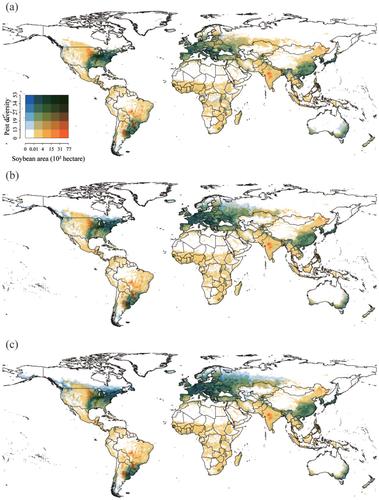当前位置:
X-MOL 学术
›
Pest Manag. Sci.
›
论文详情
Our official English website, www.x-mol.net, welcomes your feedback! (Note: you will need to create a separate account there.)
Climate change effects on the diversity and distribution of soybean true bugs pests
Pest Management Science ( IF 3.8 ) Pub Date : 2024-06-22 , DOI: 10.1002/ps.8243 Juhong Chen 1 , Kun Jiang 1, 2 , Yanfei Li 1 , Shujing Wang 1 , Wenjun Bu 1
Pest Management Science ( IF 3.8 ) Pub Date : 2024-06-22 , DOI: 10.1002/ps.8243 Juhong Chen 1 , Kun Jiang 1, 2 , Yanfei Li 1 , Shujing Wang 1 , Wenjun Bu 1
Affiliation

|
BACKGROUNDClimate change and pests are two major factors in the reduction of global soybean yields. The diversity and geographic distribution of soybean true bug pests vary across soybean production areas worldwide, and climate change impacts are different across species and regions. Therefore, we integrated spatial and temporal predictions at the global scale to predict the impact of global warming on the distribution of 84 soybean true bug pests by the maximum entropy niche model (MaxEnt) under present (1970–2000) and future (2041–2060) scenarios. We produced an ensemble projection of the potential distribution of pests and crop production areas to estimate how and where climate warming will augment the threat of soybean true bug pests to soybean production areas.RESULTSOur results indicated that Southeast North America, Central South America, Europe and East Asia were the regions with the higher richness of soybean true bug and the most vulnerable areas to invasion threats. Climate change would promote the expansion of the distribution range and facilitate pest movement pole wards, affecting more soybean cultivated areas located in mid‐latitudes. Moreover, species with different distribution patterns responded differently to climate change in that large‐ranged species tended to increase in occupancy over time, whereas small‐ranged species tended to decrease.CONCLUSIONThis result indicates that some pests that have not yet become notable may have the chance to develop into serious pests in the future due to the expansion of their geographical range. Our findings highlight that soybean cultivated regions at mid‐latitudes would face general infestations from soybean true bug pests under global warming. These results will further facilitate the formulation of adaptation planning to minimize local environmental impacts in the future. © 2024 Society of Chemical Industry.
中文翻译:

气候变化对大豆真蝽害虫多样性和分布的影响
背景技术气候变化和病虫害是全球大豆减产的两个主要因素。世界各地大豆产区的大豆真虫害虫的多样性和地理分布各不相同,气候变化的影响也因物种和地区而异。因此,我们综合全球范围内的时空预测,利用最大熵生态位模型(MaxEnt)预测当前(1970-2000年)和未来(2041-2060年)全球变暖对84种大豆真虫害虫分布的影响。 )场景。我们对害虫和作物产区的潜在分布进行了整体预测,以估计气候变暖将如何以及在何处增加大豆真虫害虫对大豆产区的威胁。结果我们的结果表明,北美东南部、南美洲中部、欧洲和东亚是大豆真虫丰富度较高的地区,也是最容易受到入侵威胁的地区。气候变化将促使其分布范围扩大,有利于害虫向极区移动,影响更多中纬度地区的大豆种植区。此外,具有不同分布模式的物种对气候变化的反应也不同,随着时间的推移,大范围物种的占有率往往会增加,而小范围物种的占有率往往会减少。结论这一结果表明,一些尚未变得引人注目的害虫可能已经由于地理范围的扩大,未来有机会发展成严重害虫。我们的研究结果强调,在全球变暖的情况下,中纬度地区的大豆种植区将面临大豆真虫害的普遍侵扰。 这些结果将进一步促进适应规划的制定,以最大限度地减少未来对当地环境的影响。 © 2024 化学工业协会。
更新日期:2024-06-22
中文翻译:

气候变化对大豆真蝽害虫多样性和分布的影响
背景技术气候变化和病虫害是全球大豆减产的两个主要因素。世界各地大豆产区的大豆真虫害虫的多样性和地理分布各不相同,气候变化的影响也因物种和地区而异。因此,我们综合全球范围内的时空预测,利用最大熵生态位模型(MaxEnt)预测当前(1970-2000年)和未来(2041-2060年)全球变暖对84种大豆真虫害虫分布的影响。 )场景。我们对害虫和作物产区的潜在分布进行了整体预测,以估计气候变暖将如何以及在何处增加大豆真虫害虫对大豆产区的威胁。结果我们的结果表明,北美东南部、南美洲中部、欧洲和东亚是大豆真虫丰富度较高的地区,也是最容易受到入侵威胁的地区。气候变化将促使其分布范围扩大,有利于害虫向极区移动,影响更多中纬度地区的大豆种植区。此外,具有不同分布模式的物种对气候变化的反应也不同,随着时间的推移,大范围物种的占有率往往会增加,而小范围物种的占有率往往会减少。结论这一结果表明,一些尚未变得引人注目的害虫可能已经由于地理范围的扩大,未来有机会发展成严重害虫。我们的研究结果强调,在全球变暖的情况下,中纬度地区的大豆种植区将面临大豆真虫害的普遍侵扰。 这些结果将进一步促进适应规划的制定,以最大限度地减少未来对当地环境的影响。 © 2024 化学工业协会。











































 京公网安备 11010802027423号
京公网安备 11010802027423号